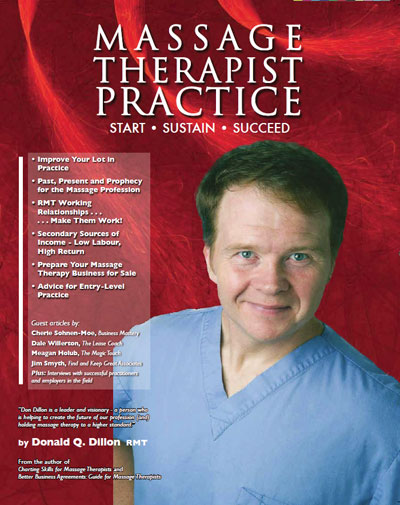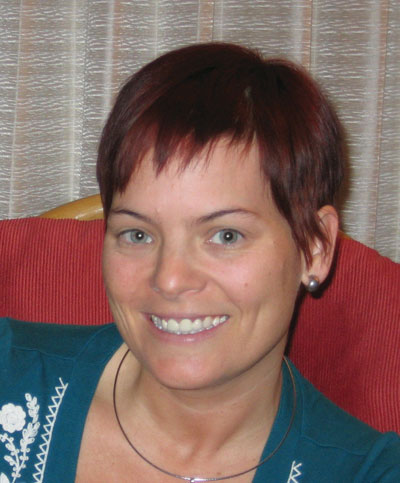
Features
Finance
Management
Evolving Business Philosophy
Don Dillon’s book is very aptly named: Massage Therapy Practice. Start.Sustain.Succeed.
January 4, 2012 By Andrea Collins
Don Dillon’s book is very aptly named: Massage Therapy Practice. Start.Sustain.Succeed. He has used his 20 years of experience in the massage therapy field to counter the traditional way we establish our practices as massage therapists. This book explores several topics that will help to shape our business philosophy.
 |
|
What elevates Don’s book is the accumulated experience he has gathered and, more importantly, the extensive research from outside our profession. He has investigated successful business models and theories of successful businesses and adapted them to apply to our field. This information will help to elevate the massage profession, should we choose to educate ourselves.
No matter where you are in your massage therapist professional timeline, this book will be relevant. The table of contents is streamlined to narrow your focus to the specific area of interest for your particular situation or question.
Opportunities and Challenges
Don begins with “examining the massage profession’s historical context in light of current opportunities and threats, and the implications for massage therapist practice.”p5 He highlights the fact that we will face challenges in the future but do not need to be alone in this struggle. He proposes collaboration with other complementary and alternative medicine (CAM) therapists to present a unified front and increase our presence in the health-care field.
In his words,
… all CAM professionals are pursuing the same goals: generating research and evidence-based practice, lobbying with insurance industry for better service funding, and raising the standards of education and training with their respective practitioners. Working separately, each profession is limited by resources and is ultimately slow and ineffective. Meeker suggests CAM professionals collaborate on resources, share knowledge and coordinate lobbying and education initiatives.p26
Working Relationships
The largest section of the book, Chapter II, is focused on “Practitioner Working Relationships.” This is an illuminating collection of information for both the massage therapist and the clinic owner. Don and the other contributors to this section are instrumental in raising awareness regarding options that have traditionally neither been considered nor thought applicable to our profession. Concepts like “pay for productivity not tenure” p52, where Don discusses progressive, incentive-based working terms; “intuition versus doing the math” p59 as a method that currently dominates our current train of thought; and the idea of introducing benefits (medical, dental and/or profit sharing plans) as incentives to create loyalty. p54
I found this section challenged my own thoughts of how I have previously approached working relationships within a clinic. I really liked how Don broke everything down to the “dollars and cents” when determining fair market value. He recommends that both owner and therapist evaluate their value to each other, and more importantly, express it to the other party in a productive way (shown in a case study on page 68). When I hear some RMTs complaining that their arrangement is awful and they are giving too much to the owner, I would highly recommend they read Don’s book to have them see the “other side” of the equation.
Longevity
Chapter III is focused on other sources of income to tap into during your career. As massage therapists we face a natural limit – we can only physically do a certain number of treatments in one day and over a week. Over time, this model will eventually take a toll on our bodies and this will “limit our ability to generate sufficient means for ourselves and our families.” Don proposes:
“What if we re-engineer the one-hour model to provide better care for even more patients/clients in a day while reducing strain on our bodies and improving our income potential? Or what if we could generate income through secondary sources that complement our primary source?” p88
He discusses how we could incorporate other therapies depending on our specific setup. Don goes on to “explore 12 profitable, low- or no hands-on complementary ways to generate income in a massage therapy practice.” p89 I found these ideas particularly inventive and they will probably challenge most therapists who really only identify themselves with “pure” massage therapy treatments. One way to approach this chapter is to think of having two options: help more people in the short term and burn out doing the “pure” massage that we were taught in school, or have an open mind and try some of the suggestions that Don offers, potentially prolonging your career. This would allow you to help your clients for the long term and to do the thing that you love to do longer!
Selling your practice
Selling your practice is a foreign concept to most massage therapists, not because it is not a viable option, but because we are uninformed about how to do it – this is addressed in Chapter IV. Don examines selling your practice when you need to relocate, when you must change the focus of your practice or as a financial boost for your retirement. He walks the reader through questions to ask about elements such as selling to a third party or valuating your business, and answers the question “are you able to sell your contact list?” This information gives hope to therapists that they will be able to profit from the years of hard work they have put into their practice.
Don’t begin at the beginning
One last suggestion for fully appreciating the content of this book is to read the closing on page 141 first. Don explains how he intends the reader to use this book and his goal of providing a journal format. He has designed the book with substantial margins for you, the reader, to mark down your personal take on the content.
Overall, this book was not overwhelming to comprehend and the concepts were easy to understand and, therefore, easy to translate into action. I wish this book had been available earlier in my career and definitely when I opened my clinic – I would have implemented several of his suggestions within my practice. This book will open dialogues and start the discussions needed to help elevate the profession of registered massage therapy.
 |
Andrea Collins, RMT, has been a massage therapist for over 12 years. Andrea has worked in a variety of settings, owned her own clinic and now practises from her home. Andrea has created techniques and business workshops to help therapists expand their practice and will be teaching the business course at a private massage college starting in January. She is currently working on a Business book for RMTs that is due out this year. For more information about Andrea please visit www.haltonholistichands.ca .
Print this page